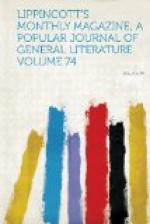Yet what a sense of utter reverse of fortune comes upon one after the first shock of the beauty of these delicate stone fantasies! Wherever we went—in the Dewani Aum or hall of audience; in the Akbari Hammun or imperial baths; in the Sammam Burj or private palace of the padishahs, that famous and beautiful palace over whose gate the well-known inscription stands, “If there is a Paradise on earth, it is here;” in the court, in the garden—everywhere was abandonment, everywhere the filthy occupations of birds, everywhere dirt, decay, desolation.
It was therefore a prodigious change when, emerging from the main gate of the palace, we found ourselves in the great thoroughfare of Delhi, the Chandni Chowk (literally “Shining street"), which runs straight to the Lahore gate of the city. Here an immense number of daily affairs were transacting themselves, and the Present eagerly jostled the Past out of the road. The shops were of a size which would have seemed very absurd to an enterprising American tradesman, and those dealing in the same commodities appeared to be mostly situated together—here the shoemakers, there the bankers, and so on.
The gold-embroidered cloths—Delhi is famous for them—made me think of those embroidered in stone which we had just seen in the Dewani Khas. These people seem to dream in curves and flowing lines, as the German dreams in chords and meandering tones, the Italian in colors and ripe forms.
("And as the American—?” said Bhima Gandharva with a little smile as we were walking down the Chandni Chowk.
“The American does not dream—yet,” I answered.)
[Illustration: THE GRAND HALL OF THE DEWANI KHAS IN THE PALACE OF DELHI.]
We saw much of the embroidered fabrics known as “kincob” (properly, kunkhwab) and “kalabatu;” and Bhima Gandharva led me into an inner apartment where a nakad was manufacturing the gold thread (called kalabatoon) for these curious loom embroideries. The kalabatoon consists of gold wire wound about a silk thread; and nothing could better illustrate the deftness of the Hindu fingers than the motions of the workman whom we saw.




